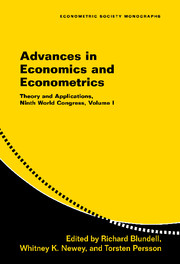Book contents
- Frontmatter
- Contents
- Contributors
- Introduction by the Editors
- Advances in Economics and Econometrics
- 1 The Economics of Social Networks
- 2 Multi-Contracting Mechanism Design
- 3 Allocative and Informational Externalities in Auctions and Related Mechanisms
- 4 The Economics of Relationships
- 5 Information in Mechanism Design
- 6 Communication in Economic Mechanisms
- 7 Advances in Dynamic Optimal Taxation
- 8 Quantitative Macroeconomic Models with Heterogeneous Agents
- 9 Modeling Inefficient Institutions
- 10 Whither Political Economy? Theories, Facts and Issues
- 11 Comments on Acemoglu and Merlo
- Index
- Titles in the series
8 - Quantitative Macroeconomic Models with Heterogeneous Agents
Published online by Cambridge University Press: 05 January 2013
- Frontmatter
- Contents
- Contributors
- Introduction by the Editors
- Advances in Economics and Econometrics
- 1 The Economics of Social Networks
- 2 Multi-Contracting Mechanism Design
- 3 Allocative and Informational Externalities in Auctions and Related Mechanisms
- 4 The Economics of Relationships
- 5 Information in Mechanism Design
- 6 Communication in Economic Mechanisms
- 7 Advances in Dynamic Optimal Taxation
- 8 Quantitative Macroeconomic Models with Heterogeneous Agents
- 9 Modeling Inefficient Institutions
- 10 Whither Political Economy? Theories, Facts and Issues
- 11 Comments on Acemoglu and Merlo
- Index
- Titles in the series
Summary
INTRODUCTION
The present paper reviews recent research aimed at constructing a theoretical model of the macroeconomy with five key elements: (i) it is based on rational decision-making by consumers and firms using standard microeconomic theory beginning with assumptions on preferences and technology; (ii) it is dynamic, so that savings and investment decisions are determined by intertemporal decisions; (iii) it has stochastic aggregate shocks, which lead to macroeconomic upswings and downswings; (iv) it considers general equilibrium, so that factor prices and interest rates are endogenous; and (v) it has a heterogeneous population structure where consumers differ in wealth and face idiosyncratic income shocks against which they cannot fully insure. As argued by Lucas (1976), the four first elements seem necessary in any model that aims to evaluate the effects and desirability of economic policy, and they are by now standard and rather broadly accepted as very important if not indispensable. What is new in the present work is the fifth element: heterogeneity.
The incorporation of a cross-section of consumers, with an accompanying nontrivial determination of the wealth distribution and of individual wealth transitions, is important for at least two reasons. First, it constitutes a robustness check on representative-agent macroeconomic models. Wealth is very unevenly distributed in actual economies. Moreover, a wide range of applied microeconomic studies suggests that, because of the incompleteness of insurance markets, wealth aggregation – equal propensities to save, hedge against risk, and work – fails.
Information
- Type
- Chapter
- Information
- Advances in Economics and EconometricsTheory and Applications, Ninth World Congress, pp. 298 - 340Publisher: Cambridge University PressPrint publication year: 2006
Accessibility standard: Unknown
Why this information is here
This section outlines the accessibility features of this content - including support for screen readers, full keyboard navigation and high-contrast display options. This may not be relevant for you.Accessibility Information
- 14
- Cited by
